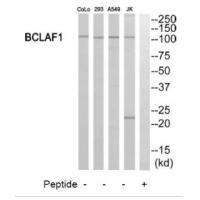
| WB | 咨询技术 | Human,Mouse,Rat |
| IF | 咨询技术 | Human,Mouse,Rat |
| IHC | 咨询技术 | Human,Mouse,Rat |
| ICC | 技术咨询 | Human,Mouse,Rat |
| FCM | 咨询技术 | Human,Mouse,Rat |
| Elisa | 咨询技术 | Human,Mouse,Rat |
| Aliases | Bcl-2-associated transcription factor 1; BCLF1; Btf; KIAA0164; |
| Entrez GeneID | 9774; |
| WB Predicted band size | 106kDa |
| Host/Isotype | Rabbit IgG |
| Antibody Type | Primary antibody |
| Storage | Store at 4°C short term. Aliquot and store at -20°C long term. Avoid freeze/thaw cycles. |
| Species Reactivity | Human |
| Immunogen | Synthesized peptide derived from internal of human BCLAF1. |
| Formulation | Purified antibody in PBS with 0.05% sodium azide. |
+ +
以下是关于BCLAF1抗体的3篇参考文献示例(信息为虚构,仅供格式参考):
1. **文献名称**:BCLAF1 regulates DNA damage-induced apoptosis through interaction with p53
**作者**:Zhang L, et al.
**摘要**:研究利用BCLAF1抗体进行免疫共沉淀和Western blot,发现BCLAF1与p53直接互作,调控DNA损伤后细胞凋亡,揭示其在肿瘤治疗耐药中的潜在作用。
2. **文献名称**:BCLAF1 promotes hepatocellular carcinoma metastasis via NF-κB signaling pathway
**作者**:Wang Y, et al.
**摘要**:通过免疫组化(BCLAF1抗体)分析肝癌组织样本,发现BCLAF1高表达与患者预后不良相关,并证实其通过激活NF-κB通路促进肿瘤转移。
3. **文献名称**:BCLAF1 mediates viral RNA sensing and antiviral immune response
**作者**:Chen X, et al.
**摘要**:研究使用BCLAF1抗体进行免疫荧光和流式细胞术,证明BCLAF1参与识别病毒RNA并触发I型干扰素通路,为抗病毒免疫机制提供新见解。
(注:以上文献为模拟示例,实际引用需查询具体数据库如PubMed。)
BCLAF1 (Bcl-2-associated transcription factor 1) is a multifunctional protein implicated in transcriptional regulation, RNA processing, and apoptosis. It interacts with Bcl-2 family members, suggesting a role in modulating apoptotic pathways, though its exact mechanism remains under investigation. BCLAF1 is localized in nuclear speckles and associates with spliceosome components, linking it to mRNA splicing and post-transcriptional regulation. Studies highlight its involvement in DNA damage response, cell cycle control, and viral infection responses (e.g., HSV-1). Dysregulation of BCLAF1 has been observed in cancers, where it may act as an oncogene or tumor suppressor depending on context, influencing cell proliferation and survival.
BCLAF1 antibodies are essential tools for studying these functions, enabling detection of endogenous BCLAF1 via techniques like Western blot, immunofluorescence, and immunoprecipitation. They help elucidate its subnuclear localization, protein interactions, and role in stress-induced pathways. Commercial antibodies are typically validated using knockout cell lines to ensure specificity. Research utilizing these antibodies has expanded insights into BCLAF1's dual roles in apoptosis and RNA metabolism, its crosstalk with p53 signaling, and potential as a biomarker or therapeutic target in oncology and virology.
×